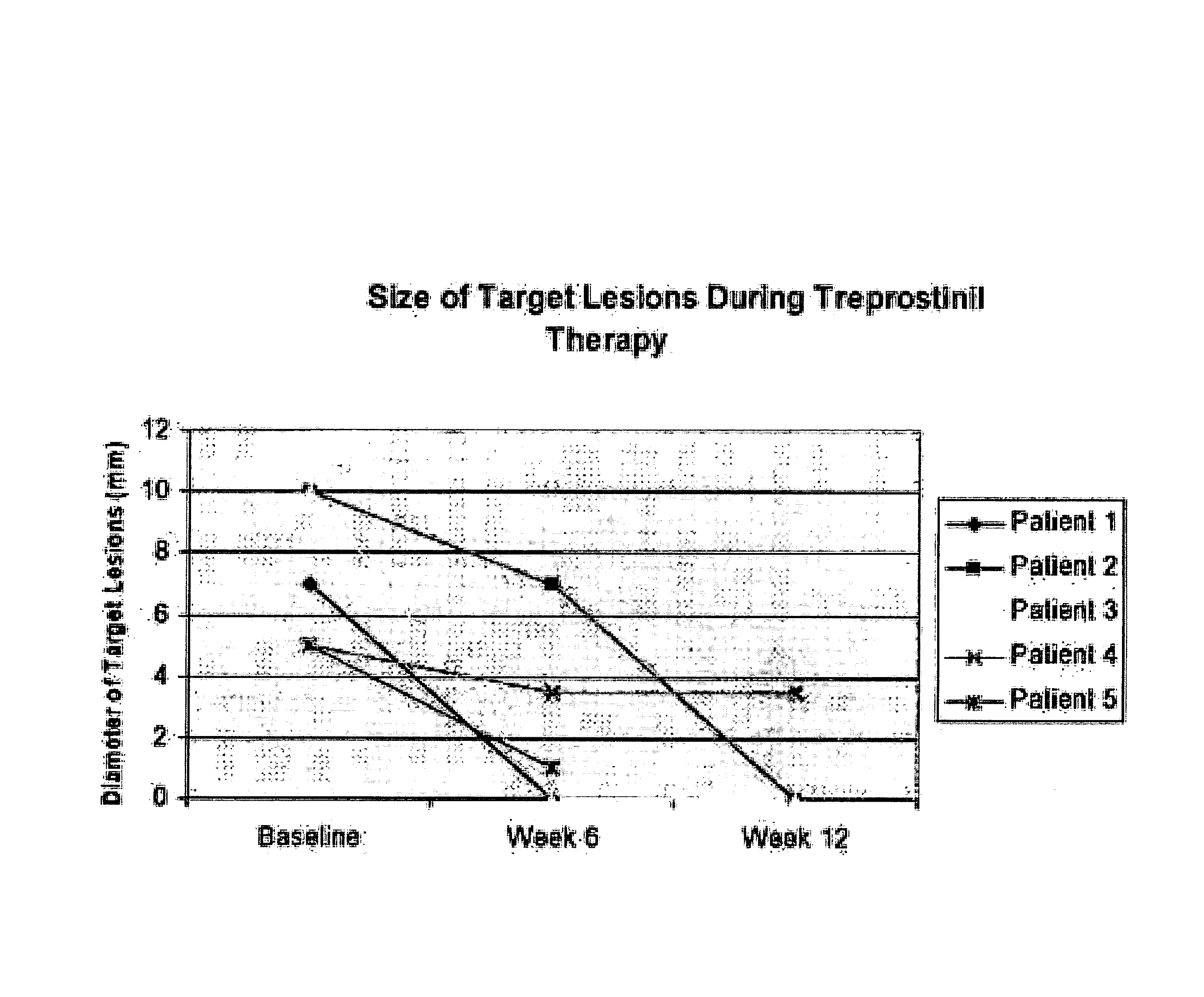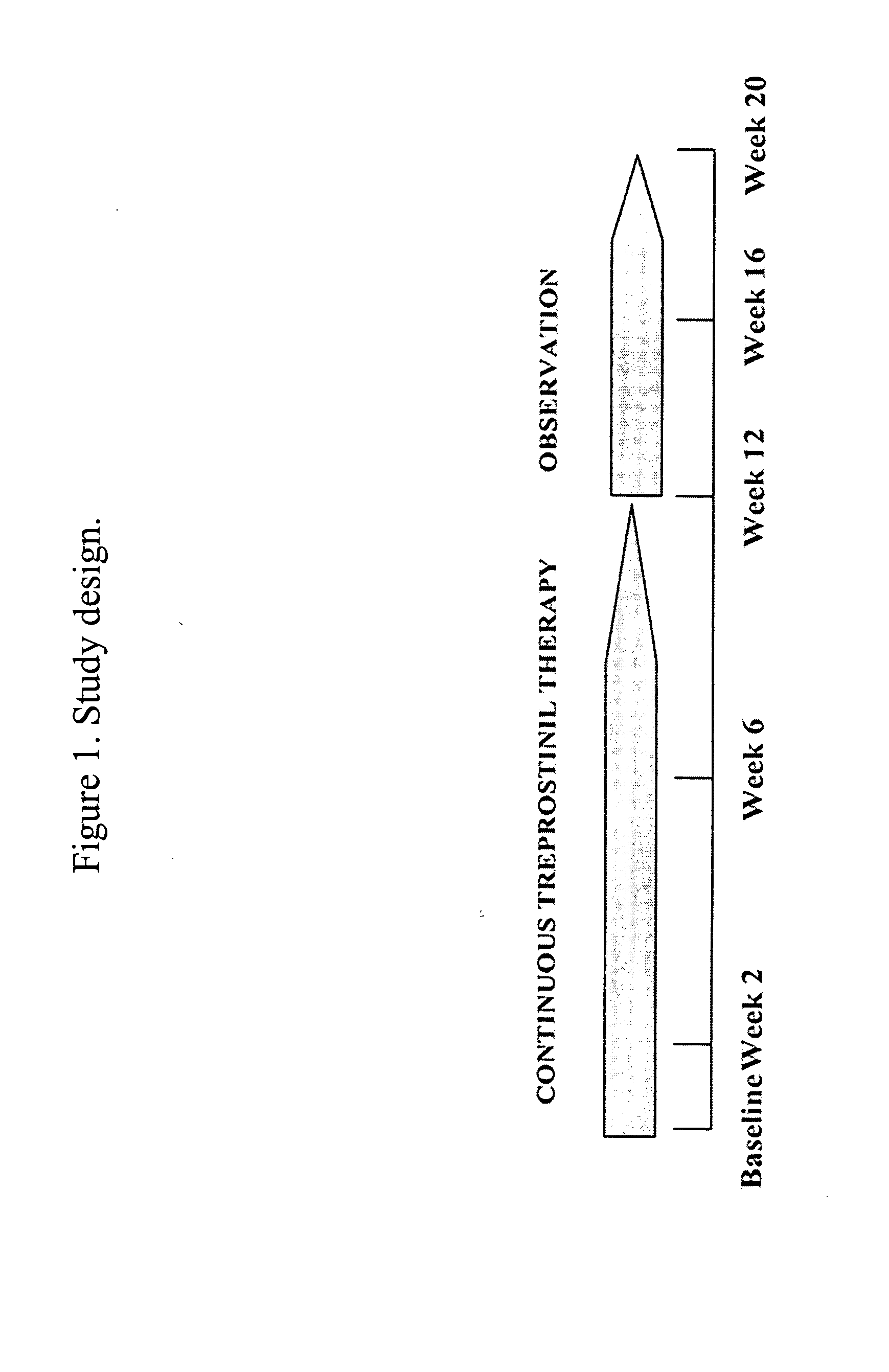Use of treprostinil to treat and prevent ischemic lesions
a technology of ischemic lesions and treprostin, which is applied in the field of treprostinil, can solve the problems of limited therapeutic options, failure to achieve, and rarely indicated revascularization, so as to reduce the occurrence, number, size and severity
- Summary
- Abstract
- Description
- Claims
- Application Information
AI Technical Summary
Benefits of technology
Problems solved by technology
Method used
Image
Examples
example 1
Administration of Treprostinil to Humans with Scleroderma Suffering from Digital Ischemic Lesions
[0051] Scleroderma patients having at least one lesion (i.e., small sore or area of tissue gangrene) present on a hand or finger are dosed with increasing amounts of Treprostinil over 12 weeks. The medication is delivered by a small pump that is connected to a catheter placed under the skin. In this manner, increasing dosages of Treprostinil are administered to patients by chronic continuous subcutaneous infusion.
[0052] Specifically, a 1.0 mg / mL formulation of Treprostinil sodium (REMODULIN®) is administered subcutaneously using a standard micro-infusion, positive-pressure infusion pump designed for subcutaneous drug delivery (Mini-Med). Patients receive an initial dose of 2.5 ng / kg / min of study drug. If, in a given patient, a dose of 2.5 ng / kg / min is not tolerated (e.g., persistent headache, nausea, emesis, restlessness, anxiety or severe pain at infusion site that cannot be adequate...
example 2
Study of Treprostinil (Remodulin®) for the Treatment and Prevention of Digital Ischemic Lesions in Patients with Systemic Sclerosis
[0055] Digital ischemic lesions (DIL) occur in up to 35% of patients with systemic sclerosis and are exquisitely painful, often progressing to necrosis requiring amputation. The purpose of this study was to evaluate the effect of Treprostinil on the healing and prevention of DIL in patients with systemic sclerosis.
[0056] Methods: This study involved 12 subjects with diffuse or limited scleroderma with at least one DIL that had been present for 2 months or more (Table 1). Subjects who completed the study were treated for 12 weeks with Treprostinil and followed for another 8 weeks after drug discontinuation (FIG. 1).
TABLE 1Baseline Patient DemographicsPatient12345Age (years)3663485241GenderFemaleFemaleFemaleFemaleFemaleLimited v. DiffuseDiffuseDiffuseDiffuseDiffuseDiffuseDisease Duration5.114.21.71.71.7(years)Smoking HistoryNeverNeverCurrentRemote1Cur...
example 3
Treprostinil Sodium Provides Symptom Relief in Severe Buerger's Disease
Background
[0061] Buerger's disease (thromboangiitis oliterans or TAO) is a clinical syndrome characterized by the development of segmental thrombotic occlusions of the medium and small arteries. The disease is clinically and pathologically distinguishable from atherosclerotic disease. Histopathology features may vary with the duration of the disease. In the chronic or end stage phase of the disease, only organized thrombus and fibrosis of the blood vessel is seen. In all stages of the disease, the normal structure of the vessel wall generally remains intact. Angiographic features of Buerger's disease are the involvement of small and medium sized vessels, segmental occlusive lesions, more severe disease distally and collateralization around areas of occlusion (corkscrew collaterals). Olin, Jeffery W., Current Concepts: Thromboangiitis Obliterans (Buerger's Disease), N. Engl. J. Med., Volume 343(12), 864-869 (S...
PUM
| Property | Measurement | Unit |
|---|---|---|
| concentrations | aaaaa | aaaaa |
| concentrations | aaaaa | aaaaa |
| concentrations | aaaaa | aaaaa |
Abstract
Description
Claims
Application Information
 Login to View More
Login to View More - R&D
- Intellectual Property
- Life Sciences
- Materials
- Tech Scout
- Unparalleled Data Quality
- Higher Quality Content
- 60% Fewer Hallucinations
Browse by: Latest US Patents, China's latest patents, Technical Efficacy Thesaurus, Application Domain, Technology Topic, Popular Technical Reports.
© 2025 PatSnap. All rights reserved.Legal|Privacy policy|Modern Slavery Act Transparency Statement|Sitemap|About US| Contact US: help@patsnap.com



